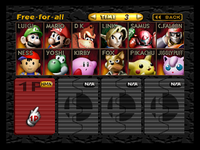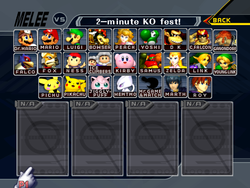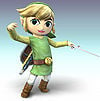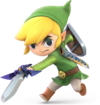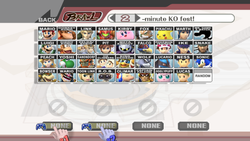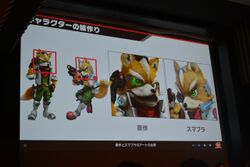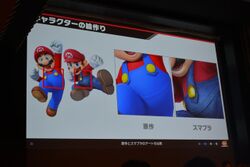Character artwork
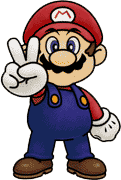
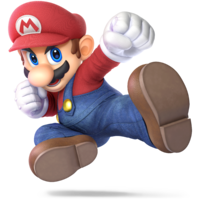
Character artwork refers to the official images of the playable Smash fighters used in-game and in promotional materials such as websites, strategy guides, and posters. In the original Super Smash Bros., the artwork for the characters were 2D illustrations not seen in the game itself. From Melee onward, however, they were rendered from 3D models at a far higher quality than how they appear in gameplay. In Melee, some pieces of character artwork were used in-game. Starting in Brawl, cropped versions of the character artwork are used in the character selection screen. In Brawl and Smash 4, each character's main render also serves as the basis of their Classic Mode trophy. The character renders in Smash 4 and Ultimate were also the basis of the poses for the Super Smash Bros. series of amiibo.
Super Smash Bros.
The character artwork of Super Smash Bros. is very different from all the games proceeding it, not only because of the 2D artwork but also due having a very unique style from other artwork at the time. Instead of being created in a more realistic and detailed matter, the roster is drawn in a more simplified, cartoony style. Characters that are drawn noticeably different from their original series are Link and Fox, who have a very different look that is never seen outside of other official artwork.
Strangely, despite all characters having artwork created for this game, the in-game character select screen rather takes already existing artwork from the respective franchise. The artwork on the select screen includes 2D and 3D artwork, and all are edited to look like renders.
Each of the character select screen artwork and their origins are down below:[1]
- Mario: A render from Super Mario 64.
- Donkey Kong: A render from Donkey Kong Country.
- Link: Artwork from The Legend of Zelda: Ocarina of Time.
- Samus: Artwork from Super Metroid.
- Yoshi: Artwork from Super Mario World 2: Yoshi’s Island.
- Kirby: Artwork from Kirby's Adventure, however, it seems to be edited with Sword Kirby artwork from Kirby Super Star.
- Fox: Artwork from Star Fox 64.
- Pikachu: Artwork from Pocket Monster Blue Version.
- Luigi: Seems to be original, based on Super Mario 64, although there is still a lot of speculation on where the origin of this artwork comes from.
- Ness: Artwork from Earthbound.
- Captain Falcon: Artwork from F-Zero X.
- Jigglypuff: Artwork from Pocket Monster Red/Green Version.
Super Smash Bros. Melee
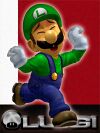
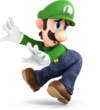
Right: Luigi's Ultimate render which shows him in his most current design.
Super Smash Bros. Melee was the first game in the series that started using 3D renders with a semi-realistic artstyle, which will be used for every game proceeding it. However, compared to all other games after Melee, the roster looks noticeably different: due to being released slightly after the launch of the Nintendo GameCube, characters that appeared on the Nintendo 64 retain their early 3D designs, causing the game to look very unique to many other games even outside of the Smash Bros. series. One example is Luigi who has his design from games such as Mario Kart 64 and Mario Party that lack his more lanky anatomy that games afterwards will provide him as.
Similar to Smash 64, its character select screen has unique artwork that are very different from their main ones, but unlike Smash 64, these pieces of artwork retain Melee's artstyle. Donkey Kong, Jigglypuff, and Bowser are a few characters which use different renders on the select screen.
Super Smash Bros. Brawl
Super Smash Bros. Brawl was the first game to use fully realistic artwork for all of the characters. Character design and graphics strayed away from the groundwork created from Melee to fit all modern designs made during the Nintendo GameCube and early Wii era, which is mainly seen in all artwork. Brawl is well-known for its drastic changes with more dark shading, more realistic proportions and textures. While characters like Snake in this type of art style seems more naturally, others like Toon Link and many characters in a series with a more colorful style look slightly different in comparison. Also many of the characters weren't based on their appearance at the time like Snake, Yoshi, and Ike.
Unlike both predecessors, Brawl was the first game in the series to match the characters character select screen art with the official artwork, and all games afterwards will have screens that act in the same way.
Super Smash Bros. 4
For the art style of Super Smash Bros. for Nintendo 3DS and Wii U, it follows the tread of Brawl basing its characters on modern artwork from each series, however, colors are much more vibrant. With the game and its artwork being a lot colorful, other original traits from Brawl's art style have been noticeably changed: details like fur, clothing, and armor are more detailed and look less muddy in comparison. Some characters switch from their most modern looks that were created between the timespan of Brawl and Smash 4, with Samus, Roy and Ike having their Other M, Awakening, and Radiant Dawn interpretations respectively, although there are some exceptions such as Legend of Zelda and Star Fox characters who had Twilight Princess and Assault designs being intact.
Super Smash Bros. Ultimate
Ultimate's art style was created to be an in-between of being colorful and detailed to avoid many different game worlds from having clashing visuals. All characters were made to fit this type of middle ground: characters like Mario would be given a slightly less colorful appearance but be more detailed, while someone like Fox, whose character design in Ultimate was based on Star Fox Zero, will have less detailed fur and clothes to be more visually similar to Mario and other characters.
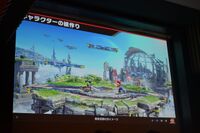
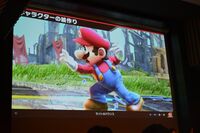
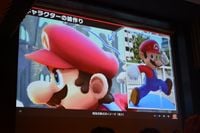
Middle: Mario's full body and the placements of shading on his clothing.
Right: Picture showing the shading of Mario's hat and real life figurine used for reference.Masahiro Sakurai and his team wanted the game's style and graphics have more natural lighting, and to have a basis to go off of, they took pictures of character figurines outside to see how their shading will look without being inaccurate. All pictures are concept art which showed the process of Ultimate's final art style, shown off at CEDEC.[2]
Another noticeable example of Ultimate and its art style comes from its panoramic poster, which has all base and DLC characters in the roster. The idea of the panorama was thought of by Sakurai, and was illustrated by The Legend of Zelda: Twilight Princess character designer, Yusuke Nakano. Nakano decided that it would be created with all of the roster be evenly distributed from left to right, in order to have something visually interesting anywhere you looked and not have the whole panorama feel one-sided. Also, for Nakano to get all the characters to feel as faithful as possible, he consulted their original creators on what will be their right pose.[3]

